1996 CHEVROLET ASTRO power steering
[x] Cancel search: power steeringPage 81 of 372
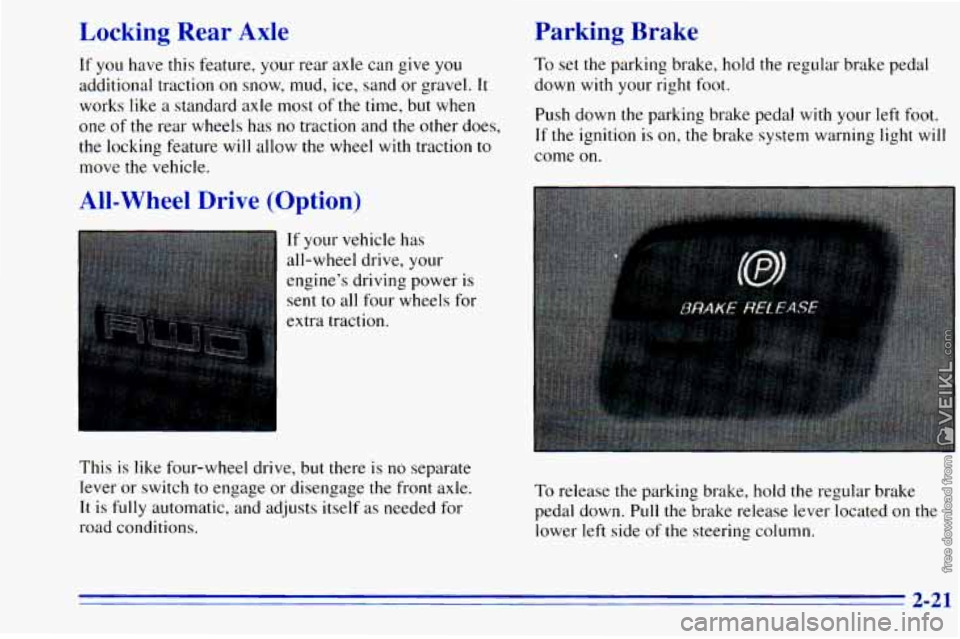
Locking Rear Axle
If you have this feature, your rear axle can give you
additional traction on snow, mud, ice, sand or gravel.
It
works like a standard axle most of the time, but when
one
of the rear wheels has no traction and the other does,
the locking feature will allow
the wheel with traction to
move the vehicle.
All-Wheel Drive (Option)
If your vehicle has
all-wheel drive, your
engine’s driving power
is
sent to all four wheels for
extra traction.
Parking Brake
To set the parking brake, hold the regular brake pedal
down with your right foot.
Push down the parking brake pedal with
your left foot.
If the ignition is on, the brake system warning light will
come on.
This is like four-wheel drive, but there is
no separate
lever or switch
to engage or disengage the front axle.
It
is fully automatic, and adjusts itself as needed for
road conditions.
To release the parking brake, hold the regular brake
pedal down. Pull the brake release lever located
on the
lower left side of the steering column.
2-21
Page 162 of 372
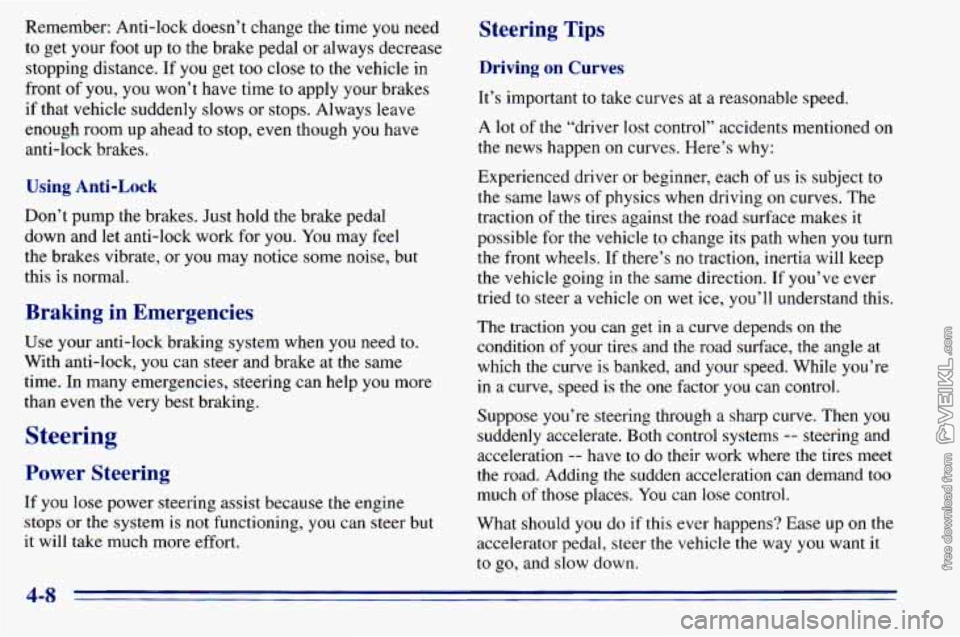
Remember: Anti-lock doesn’t change the time you need
to get your foot up
to the brake pedal or always decrease
stopping distance. If you get too close
to the vehicle in
front
of you, you won’t have time to apply your brakes
if that vehicle suddenly slows or stops. Always leave
enough room up ahead
to stop, even though you have
anti-lock brakes.
Using Anti-Lock
Don’t pump the brakes. Just hold the brake pedal
down and let anti-lock work for you. You may feel
the brakes vibrate, or you
may notice some noise, but
this
is normal.
Braking in Emergencies
Use your anti-lock braking system when you need to.
With anti-lock, you can steer and brake at the same
time. In many emergencies, steering can help you more
than even the very best braking.
Steering
Power Steering
If you lose power steering assist because the engine
stops
or the system is not functioning, you can steer but
it will take much more effort,
Steering Tips
Driving on Curves
It’s important to take curves at a reasonable speed.
A lot of the “driver lost control’’ accidents mentioned on
the news happen on curves. Here’s why:
Experienced driver or beginner, each of us is subject to
the same laws of physics when driving
on curves. The
traction
of the tires against the road surface makes it
possible for the vehicle to change its path when
you turn
the front wheels.
If there’s no traction, inertia will keep
the vehicle going
in the same direction. If you’ve ever
tried to steer a vehicle
on wet ice, you’ll understand this.
The traction
you can get in a curve depends on the
condition of your tires and the road surface, the angle
at
which the curve is banked, and your speed. While you’re
in a curve, speed is the one factor
you can control.
Suppose you’re steering through a sharp curve. Then
you
suddenly accelerate. Both control systems -- steering and
acceleration
-- have to do their work where the tires meet
the road. Adding the sudden acceleration can demand too
much
of those places. You can lose control.
What should you do
if this ever happens? Ease up on the
accelerator
pedal, steer the vehicle the way you want it
to
go, and slow down.
4-8
Page 239 of 372
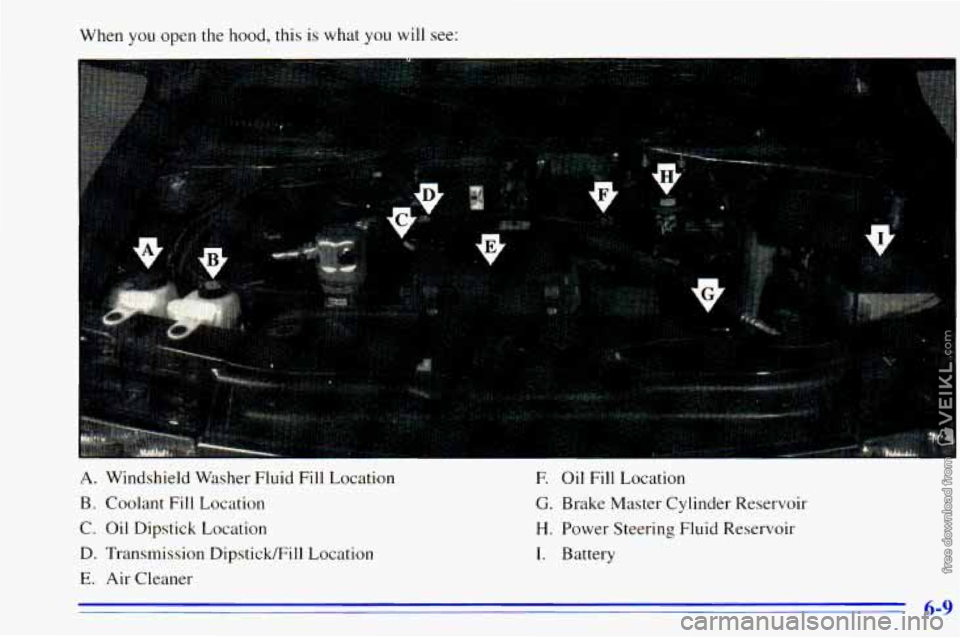
When you open the hood, this is what you will see:
-
A. Windshield Washer Fluid Fill Location
B. Coolant Fill Location
C. Oil Dipstick Location
D. Transmission Dipstick/Fill Location
E. Air Cleaner
6-9
F. Oil Fill Location
G. Brake Master Cylinder Reservoir
H. Power Steering Fluid Reservoir
I. Battery
Page 260 of 372
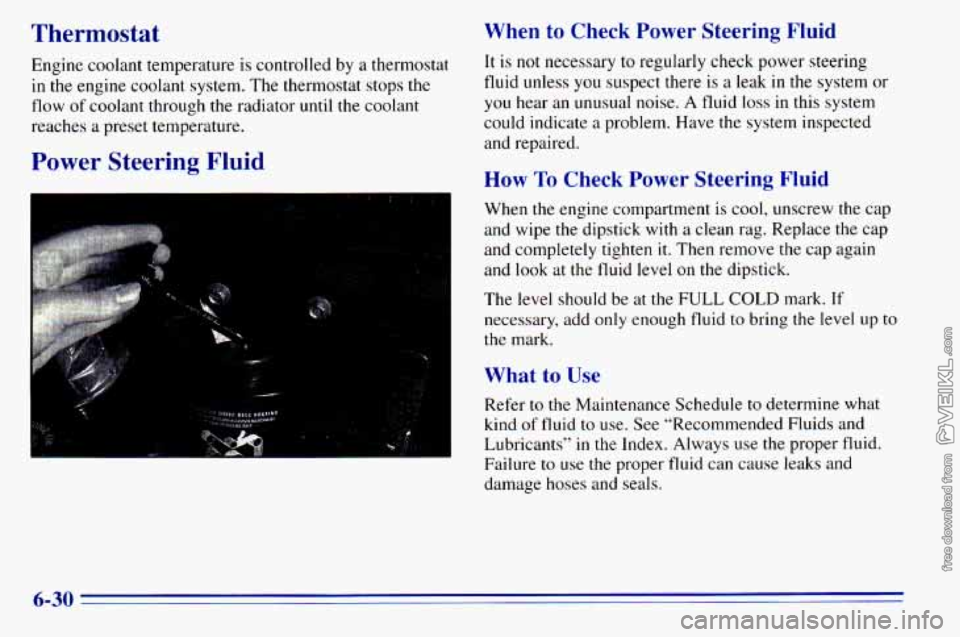
Thermostat When to Check Power Steering Fluid
Engine coolant temperature is controlled by a thermostat It is not necessary to reg,ularlY check Power steering
in the engine coolant system. The thermostat stops the fluid unless you suspect there is a leak in the system or
flow
of coolant through the radiator until the coolant you
hear an unusual noise. A fluid loss in this system
reaches a preset temperature. could indicate
a problem. Have the system inspected
and remired.
Power Steering Fluid
I
How To Check Power Steering Fluid
When the engine compartment is cool, unscrew the cap
and wipe
the dipstick with a clean rag. Replace the cap
and completely tighten
it. Then remove the cap again
and look at the fluid level
on the dipstick.
The level should be at the
FULL COLD mark. If
necessary, add only enough fluid to bring the level up to
the mark.
What to Use
Refer to the Maintenance Schedule to determine what
kind
of fluid to use. See “Recommended Fluids and
Lubricants’’
in the Index. Always use the proper fluid.
Failure to use the proper fluid can cause leaks and
damage hoses and seals.
6-30
Page 345 of 372
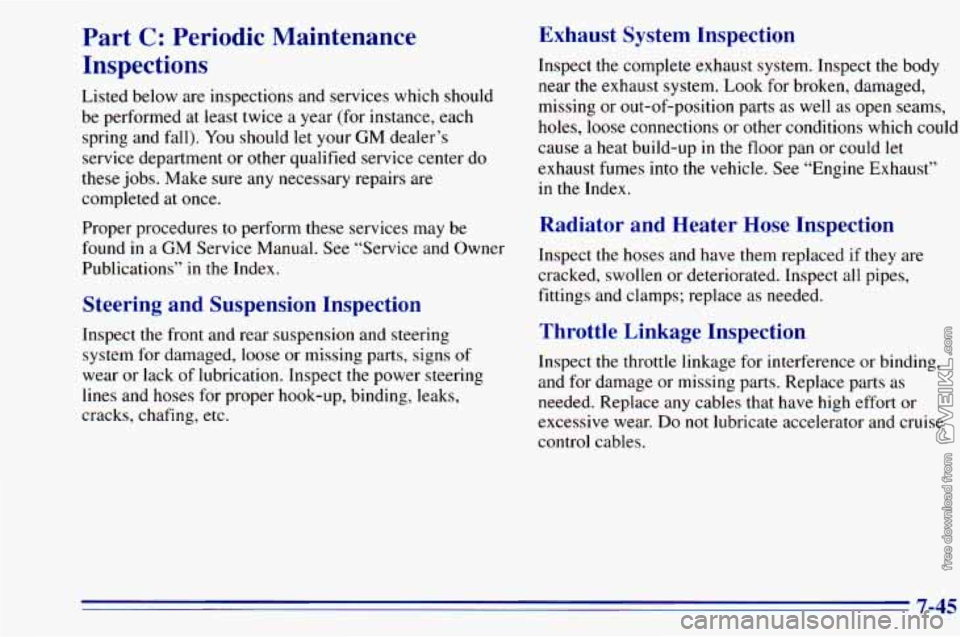
Part C: Periodic Maintenance
Inspections
Listed below are inspections and services which should
be performed
at least twice a year (for instance, each
spring and fall). You should let your GM dealer’s
service department or other qualified service center do
these jobs. Make sure any necessary repairs are
completed at once.
Proper procedures to perform these services may be
found
in a GM Service Manual. See “Service and Owner
Publications’’
in the Index.
Steering and Suspension Inspection
Inspect the front and rear suspension and steering
system for damaged, loose or missing parts, signs of
wear or lack of lubrication. Inspect the power steering
lines and hoses for proper hook-up, binding, leaks,
cracks, chafing, etc.
Exhaust System Inspection
Inspect the complete exhaust system. Inspect the body
near the exhaust system. Look for broken, damaged,
missing or out-of-position parts as well as open seams,
holes, loose connections
or other conditions which could
cause a heat build-up
in the floor pan or could let
exhaust fumes into the vehicle. See “Engine Exhaust’’
in the Index.
Radiator and Heater Hose Inspection
Inspect the hoses and have them replaced if they are
cracked, swollen or deteriorated. Inspect all pipes,
fittings and clamps; replace as needed.
Throttle Linkage Inspection
Inspect the throttle linkage for interference or binding,
and for damage or missing
parts. Replace parts as
needed. Replace any cables
that have high effort or
excessive wear.
Do not lubricate accelerator and cruise
control cables.
7-45
Page 347 of 372
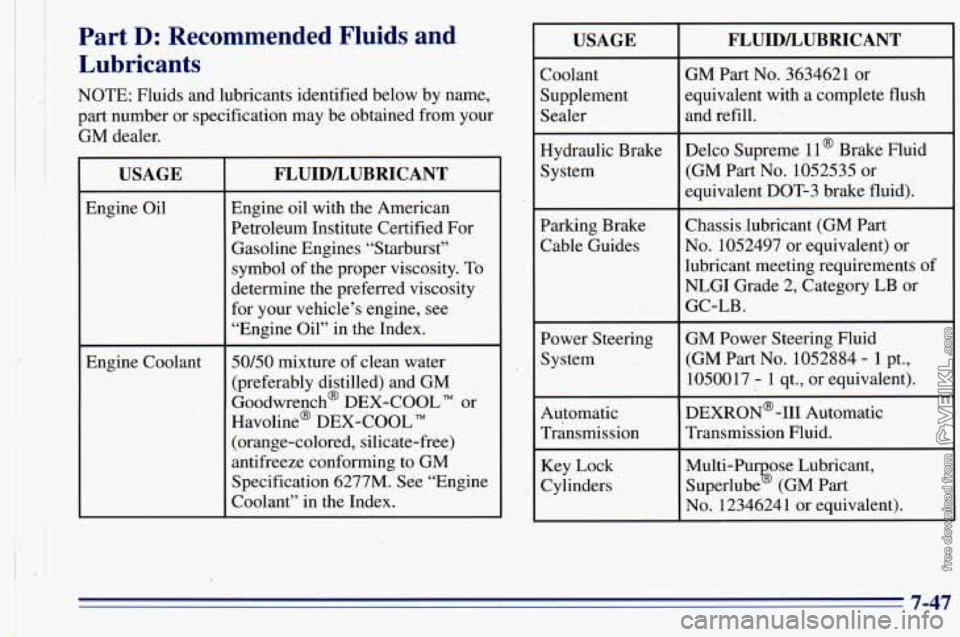
Part D: Recommended Fluids and
Lubricants
NOTE: Fluids and lubricants identified below by name,
part number or specification may be obtained from your
GM dealer.
USAGE
Engine Oil
Engine Coolant
FLUID/LUBRICANT ~~~ ~
Engine oil with the American
Petroleum Institute Certified For Gasoline Engines “Starburst”
symbol of the proper viscosity. To
determine the preferred viscosity
for your vehicle’s engine, see
“Engine Oil’’ in the Index.
~~
50/50, mixture of clean water
(preferably distilled) and GM
Goodwrench@ DEX-COOL
TM or
Havoline@ DEX-COOL
TM
(orange-colored, silicate-free)
antifreeze conformiag to GM
Specification 6277M. See “Engine
Coolant” in the Index.
USAGE
Coolant
Supplement
Sealer
Hydraulic Brake
System
~~~~~~~
Parking Brake
Cable Guides
Power Steering
System
Automatic
Transmission
Key Lock
Cylinders
FLUIDLUBRICANT
GM Part No. 3634621 or
equivalent with a complete flush
and refill.
-
Delco Supreme 11 @ Brake Fluid
(GM Part No. 1052535 or
equivalent DOT-3 brake fluid).
Chassis.1ubricant (GM Part
No. 1052497 or equivalent) or
lubricant meeting requirements of
NLGI Grade 2, Category
LB or
GC-LB.
GM Power Steering Fluid
(GM Part No. 1052884
- 1 pt.,
1050017
- 1 qt., or equivalent).
DEXRON@-I11 Automatic
Transmission Fluid.
Multi-Pu ose Lubricant,
Superlube
% (GM Part
No. 1234624 1 or equivalent).
7-47
Page 365 of 372

Instrumentpanel ............................... 2-50
Brightness Control
.................... i ....... 2-35
Cleaning
.................................... 6-53
Cluster
..................................... 2-52
FuseBlock
.................................. 6-61
Interior Lamps
................................. 2-37 Charging System
........................... 2-55
Check Gages
................................ 2-63
Check Oil
................................... 2-61
Daytime Running Lamps Indicator
............... 2-62
Safety Belt Reminder
..................... 1 - 12. 2-54
Service Engine Soon
.......................... 2-58
Loading Your Vehicle
........................... 4-26 .
J
Locks
ack. Tire .................................... 5-24
Cylinders ................................... 7-42
Jump Starting ................................... 5-2
Door ........................................ 2-5
Key Lock Cylinders Service
..................... 7-42
Keyless Entry System
............................ 2-7
Keys
.......................................... 2-1
Key Lock Cylinder Service ..................... 7-42
PowerDoor
.................................. 2-6
Sliding Door Child Security
..................... 2-10
Steering Column Lock Check
................... 7-44
Lubricants and Fluids
............................ 7-47
Lubrication Service. Body
........................ 7-42
Luggagecarrier
................................ 2-47
Certificationflire
............................. 4-26 Lumbar Controls ................................ 1-2
Service Parts Identification ..................... 6-59
Tire-Loading Information
...................... 4-26
Vehicle Identification Number
................... 6-59
Lamps ........................................ 2-35
Dome
...................................... 2-37
Interior
..................................... 2-37
OnReminder
................................ 2-36
Latches. Seatback ................................ 1-5
Leaving Your Vehicle ............................. 2-6
Leaving Your Vehicle with the Engine Running
....... 2-24
Lighter
....................................... 2-48
Lights
Air Bag Readiness ....................... 1-25. 2-54
Anti-Lock Brake System Warning
............ 2-57. 4-6
Brake System Warning
......................... 2-57 Maintenance.
Normal Replacement Parts
........... 6-69
Maintenance Record
............................ 7-49
Maintenance Schedule
............................ 7-1
Long Trip/Highway Definition
................... 7-5
Long TripMighway Intervals
..................... 7-5
Owner Checks and Services
..................... 7-41
Periodic Maintenance Inspections
................ 7-45
Recommended Fluids and Lubricants
............. 7-47
Scheduled Maintenance Services
.................. 7-2
Short Trip/City Definition
....................... 7-4
Short Trip/City Intervals ........................ 7-4
Maintenance. Underbody ......................... 6-X
9-5
Page 366 of 372

Maintenance When Trailer Towing ............... 4-36
Malfunction Indicator Lamp
...................... 2-58
ManualFrontSeat
............................... 1-1
Manual Lumbar Support .......................... 1-2
Methanol
...................................... 6-4
Mirrors
....................................... 2-38
Convex Outside
.............................. 2-39
Inside Day/Night Rearview
..................... 2-38
Outside
..................................... 2-39
Visor Vanity ................................. 2-49
MMT
......................................... 6-3
ModelReference
................................. vi
Mountain Roads ........ ................ 4-20
Net. Convenience
.............................. 2-46
Neutral
....................................... 2-19
New Vehicle Break-In
........................... 2- I3
Nightvision
................................... 4-13
Odometer
.................................... 2-53
Odometer. Trip
................................. 2-53
Off-Road Recovery
............................. 4- IO
Oil. Engine .................................... 6-11
Opener. Garage Door ............................ 2-43
Outside Mirror
................................. 2-39
Overhead Console
.............................. 2-42
Overheating Engine
............................. 5- I3
Owner Checks and Services
....................... 7-41
Owner Publications. Ordering ...................... 8-9
Paint Spotting. Chemical ........................ 6-57
Park
......................................... 2-18
Shifting Into
................................. 2-22
Shifting Out
of ............................... 2-25
AtNight
.................................... 2-13
Brake ...................................... 2-21
Brake Mechanism Check
....................... 7-44
Lots
....................................... 2-13
Over Things That Burn
......................... 2-25
With
a Trailer ................................ 4-36
Passing
....................................... 4-10
Payload
....................................... 4-28
Periodic Maintenance Inspections
.................. 7-45
Power Accessory Outlet
............................. 2-49
DoorLocks
................................... 2-5
Option Fuses
................................ 6-60
Seat ......................................... 1-3
Steering ..................................... 4-8
Steering Fluid
................................ 6-30
Windows
.................................... 2-27
Pregnancy, Use of Safety Belts
.................... 1-30
Problems on the Road
............................ 5-1
Publications, Service and Owner .................... 8-9
Parking
Radiator
..................................... 5-19
Radiator Pressure Cap ........................... 6-29
Radio Reception
................................ 3-26
Radios
........................................ 3-8
Rain. Driving In ................................ 4-14
Reading
Lamps ................................ 2-38
9-6